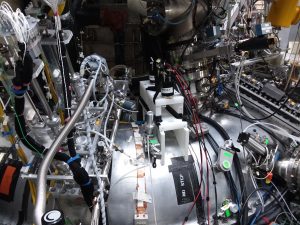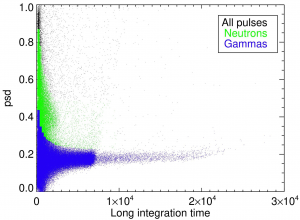A group of three scientists from Italy made use of the MST device during a two week stay this spring. ? Dr. Matteo Zuin (Consorzio RFX), Dr. Luigi Cordaro (University of Padua), and Dr. Cristiano Fontana (Istituto Nazionale di Fisica Nucleare Sezione- National Institute of Nuclear Physics) used MST plasmas with a substantial fusion neutron flux to commission a set of neutron and gamma discriminating detectors.
 The diagnostic boasts of a very fast time response with on-the-fly pulse shape discrimination to distinguish between neutron and gamma counts on the scintillator. ? This cross-discipline collaboration was especially productive in adapting nuclear physics? counting techniques to a plasma physics short pulse, high flux discharge. Previous pulse counting techniques on plasma physics experiments record the detector output for the full duration of the discharge, then analyze the pulses? between shots. ? The counting specialist, with a nuclear physics background, is accustomed to a detector that free-runs for long periods of time, ? processing the data and registering counts as they come in??” ? a technique well suited for low count rates. ? In discharges with neutral beam injection on MST,? each of the five detectors was routinely subjected to count rates exceeding 50kHz, which challenged the system’s ability to keep up.
The diagnostic boasts of a very fast time response with on-the-fly pulse shape discrimination to distinguish between neutron and gamma counts on the scintillator. ? This cross-discipline collaboration was especially productive in adapting nuclear physics? counting techniques to a plasma physics short pulse, high flux discharge. Previous pulse counting techniques on plasma physics experiments record the detector output for the full duration of the discharge, then analyze the pulses? between shots. ? The counting specialist, with a nuclear physics background, is accustomed to a detector that free-runs for long periods of time, ? processing the data and registering counts as they come in??” ? a technique well suited for low count rates. ? In discharges with neutral beam injection on MST,? each of the five detectors was routinely subjected to count rates exceeding 50kHz, which challenged the system’s ability to keep up.

In just under a week with the full crew on site, the typical challenges of experimental installations were all solved. and Dr. Fontana? stayed on another week to collect data in several different plasma conditions, including neutral-beam heated discharges with varying deuterium concentration, as well as discharges with a natural fast ion population from both strong ‘sawtooth’ reconnection events and from quiescent, high-confinement plasmas where such events are suppressed. ? It was a very successful visit overall, with the diagnostic operating robustly through all conditions. ? One challenge remains: ? with the ability to measure neutron flux on five independent detectors, a suitable collimation system will allow instantaneous measurement of a fast ion density profile. ? This addition will help answer questions on the details of the reconnection-based ion heating, the dynamics of fast ions during the transition to the RFP’s single helicity state, and the effects of fast ion driven instabilities in the Reversed Field Pinch.